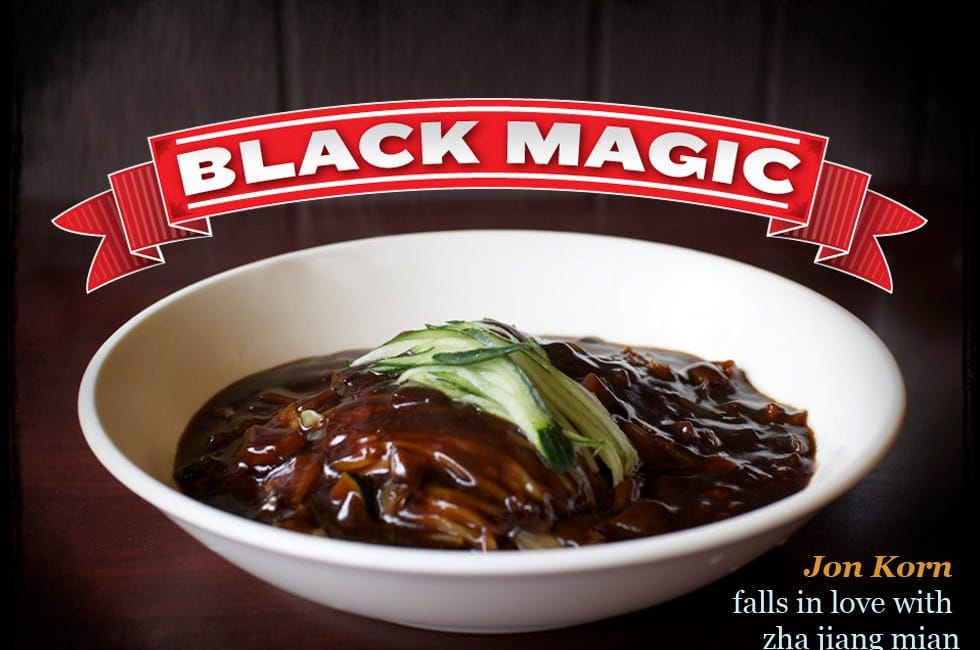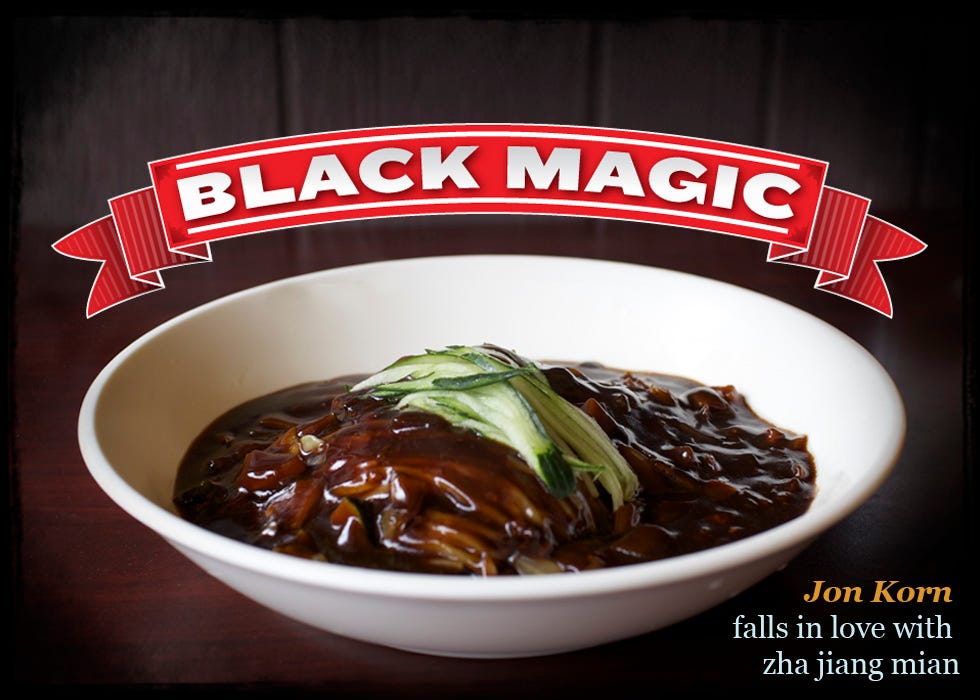
In my opinion the best food isn’t about taste as much as the process of eating.
Oysters are delicious, but a real part of their appeal comes from the rigmarole of consuming one: shucking, dressing, slurping. For the novice, learning the process is just as intimidating as the flavor. The same principle holds for everything from edamame to lobster. This is dining as discovery, cuisine as culture.
On a recent trip to Beijing, I got initiated into a new sect of food: zha jiang mian (black bean noodles). They might sound innocuous enough, but there are infinite variations of the dish from several nationalities. In its purest form, though, what we’re dealing with is a thick, tangy sauce of pork and fermented soybean paste tossed with wheat noodles. It’s up to the eater to tweak the ratio between sauce and noodles, as well as dress everything with whatever garnishes are available. (In China, this included carrots, cucumber, onion, bean sprouts, and more.) The result is simultaneously salty, sour, and sweet — complex comfort food that is as central to a family lunch as it is to a night of drinking.
Addicted and seeking my fix after returning to the Bay, I went out to sample a few of San Francisco’s interpretations of black bean noodles.
Native Tung
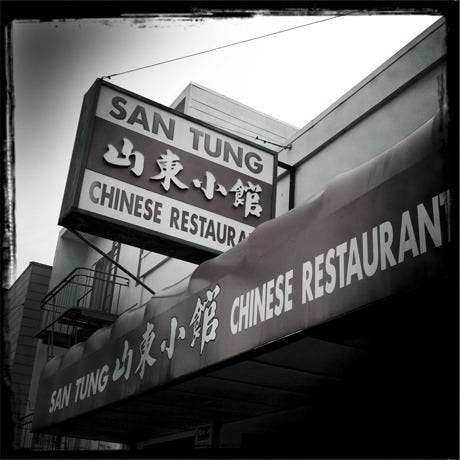
My first stop was the venerable Inner Sunset institution San Tung. Along with a full menu of solid Chinese fare, San Tung offers two slight variations of black bean sauce noodles and dry black bean sauce noodles. This use of “dry” was somewhat misleading, as the only real difference between the two was the inclusion of scallops in the latter. I tasted some of the sauce to gauge its strength before I tossed it in and got a gratifying hit of the black soybean paste’s unique musky salinity. (This is an important step — too much sauce can ruin this dish. The ideal is a light coating, like the dressing of a salad.)
As I ate, I noticed that San Tung’s noodles were homemade. Their texture was amazing, springy, and perfectly cooked.
The sauce, while thinner than I had previously experienced, was still full of flavor. I’m not made of stone, so I ordered a batch of San Tung’s rightly famous dry fried chicken wings to go with my noodles. Insanely addictive and doused in a sweet, spicy sauce, these wings stand as proof that San Tung knows as much about food as it seemingly doesn’t understand the meaning of the word ”dry.”
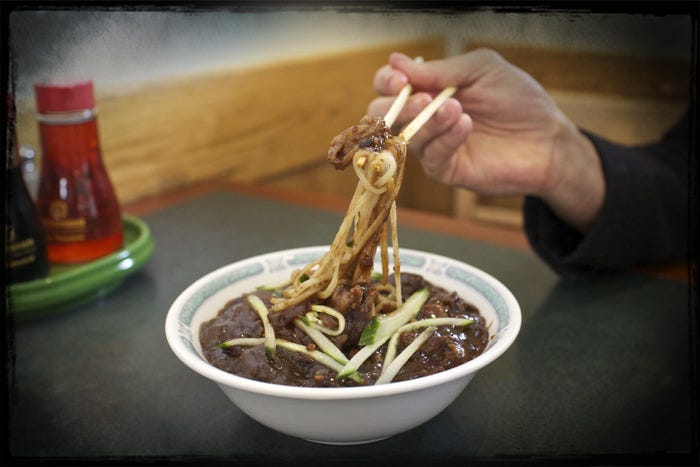
Seoul Mate
Korean cuisine has developed a national take on Mandarin food that includes such favorites as jampong (spicy seafood soup), sweet and sour pork (in a sweet, clear sauce, rather than the bright red sauce), and a version of black bean noodles called jajangmyun . These noodles feature a richer, thicker sauce and come with banchan (side dishes), including raw onion with a salty black bean sauce, sweet pickled daikon, and cabbage kimchi. I decided to try a couple versions of jajangmyun.
Say It Is So
I arrived at So in SOMA and was immediately happy. Yes, the place was warm, welcoming, and smelled like pan-Asian heaven, but none of these were the source of my delight. What gave me such joy was the outside of So’s building, which features a giant mural of the Ghostbusters battling the Stay Puft Marshmallow Man done in the style of the Simpsons. (“It was the owner’s idea,” explained the waiter with a proud smile. I officially owe this guy a high five.) The smile-train kept right on a-rollin’ with So’s menu, which offered another two takes on my favorite dish: black bean sauce and So black bean.
The style here was definitely Korean, as both versions featured rich, luxurious sauce. The black bean sauce was closest to traditional jajangmyun, with the addition of calamari.
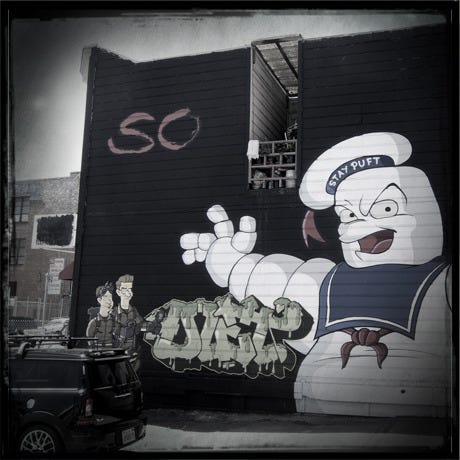
I also took advantage of the optional fried egg on top and was very happy I did. So’s black bean offered a fusion-y take on the classic, incorporating jalapeños, cayenne, and paprika. The spicy kick offered wonderful contrast to the tongue-coating richness of the black bean sauce. I balanced my meal with an order of dry sautéed green beans, which also offered an ingenious twist: house-made pickled radish tossed into the mix.
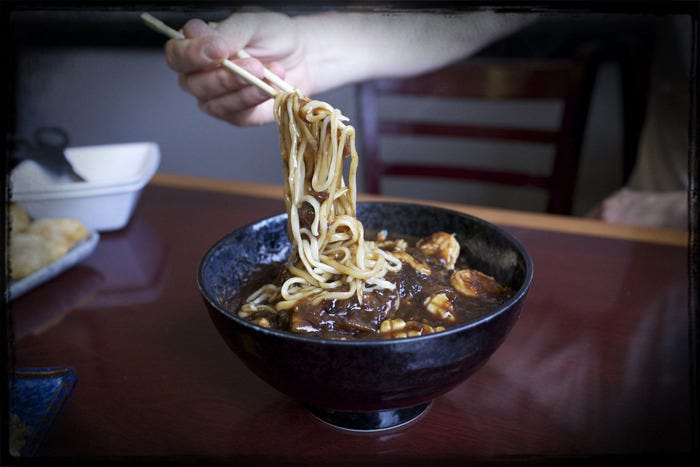
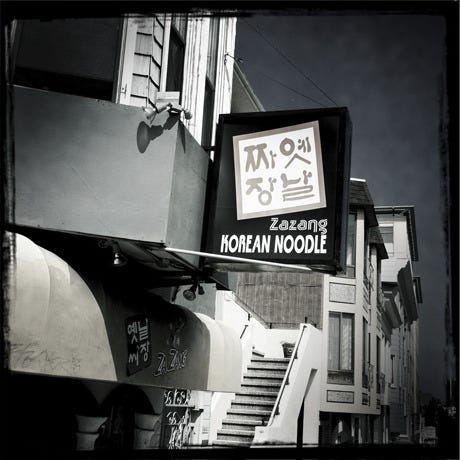
Variety Hour
As soon as I set out on my quest, I knew that I would have to visit Zazang Korean Noodle in the Western Addition. After all, the place is named after the freaking dish I was obsessed with. (“Zazang” is an alternate spelling of “jajang,” along with “zajang,” just to mix it up.) Zazang features a menu of deceptively large, cheap dishes ideal for family-style eating. In fact, the whole restaurant has a homey feel that extends to its friendly, helpful wait staff and — most importantly — the food.
Zazang also has two black bean dishes: zazangmyun and gan zazangmyun . The former is the traditional Korean version of the dish, executed in delicious fashion.
The ridiculously thick, almost creamy sauce was like a stew and was filled with tasty morsels, including big chunks of pork. The noodles, while tasty, were not homemade, although it was hard to notice anything other than that sauce. The gan zazangmyun offered a similar base, but added a healthy amount of spice and seafood to the mix. The result was less rich than the zazangmyun, but more exciting from bite to bite. Since I had come with a group, we were also able to sample the delicious jap chae (stir-fried yam noodles) and a mesmerizingly spicy seafood soup.
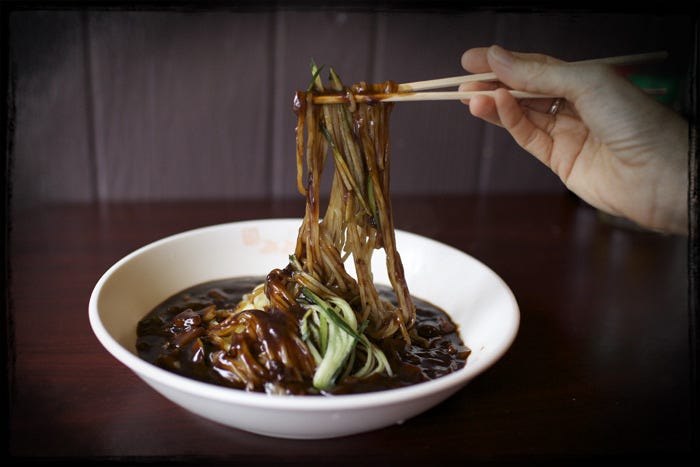
Triple Happiness
My last destination was Beijing Restaurant, which distinguished itself as being the only place I found in my search that made a Yelp reviewer burst into tears because it was so authentic. So I was already sold before I sat down and noticed Yao Ming’s face included in a photo collage of people who had eaten there. This place was serious! I ordered the black bean noodles, listed as Beijing Style Noodles with Brown Paste, just like they were in China. My waiter even tossed the noodles and some thin sliced veggies with the sauce tableside, reserving some for me to fiddle with the mix if I wanted to.
I didn’t. The thin sauce, more brown than black, was bursting with the tart, earthy flavor of fermented bean paste.
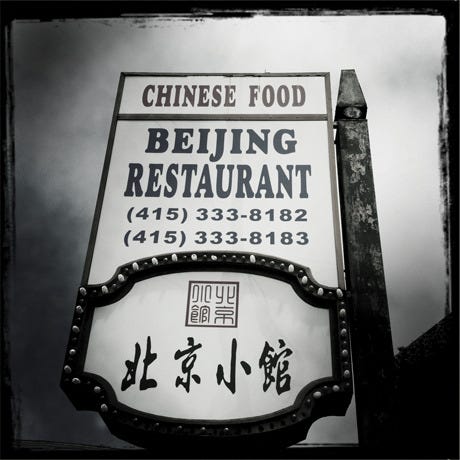
It perfectly coated the noodles, which were homemade and phenomenal. The rest of Beijing Restaurant’s menu was just as impressive, especially the dishes that featured “preserved greens,” a sort of insanely tasty Chinese sauerkraut. The easygoing waiter let us sit at our table for as long as we needed to, adding to the impression that we were in Beijing rather than San Francisco.
As much as I loved the noodles at Beijing Restaurant, I was just as happy with the other three variants I tried. Black bean noodles is a dish with unlimited potential, open to interpretations of every kind from classic to insane. And as much as I’d like to, I can’t try every place in SF myself — so get out there and eat some. Let me know about your favorites in the comments.


Looking for some black bean noodles in a familiar Chinese setting? Make a trip to the Inner Sunset to visit San Tung — just remember to save room for some wings. Interested in trying a more modern take? Go straight to So , the Ghostbuster-iest spot in SOMA. Devotees of traditional Korean jajangmyun owe it to themselves to try both styles at Zazang Korean Noodle in the Western Addition. And the aptly named Beijing Restaurant offers a supremely authentic version of the dish in Mission Terrace.



